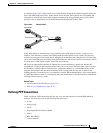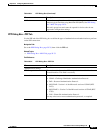
59-70
User Guide for Cisco Security Manager 4.4
OL-28826-01
Chapter 59 Configuring Router Interfaces
PPP on Cisco IOS Routers
PPP on Cisco IOS Routers
The Point-to-Point Protocol (PPP), as defined in RFC 1661, provides a method for transporting packets
between two devices or hosts using physical or logical links. PPP is a Layer 2 data-link protocol that can
work with multiple Layer 3 network-layer protocols, including IP, IPX, and AppleTalk.
PPP is used in many common scenarios, such as:
• Connecting remote users to a central network over dial-in connections.
• Connecting the gateway of an enterprise network to an ISP for internet access.
• Connecting two LANs (for example, a central office and a branch office) to exchange data between
them.
PPP connectivity is established in stages:
1. First, a Link Control Protocol (LCP) establishes, configures, and tests the data-link connection.
2. (Optional) Authentication verifies the identity of the two parties.
3. A family of Network Control Protocols (NCPs) establishes and configures the necessary
network-layer protocols.
The PPP policy in Security Manager provides a method for configuring selected parameters that are
negotiated between the two nodes during the LCP stage, including authentication (typically CHAP or
PAP) and Multilink PPP (MLP). For more information about MLP, see Defining Multilink PPP Bundles,
page 59-74.
The following topics describe the tasks you perform to create PPP policies on Cisco IOS routers:
• Defining PPP Connections, page 59-71
• Defining Multilink PPP Bundles, page 59-74
Understanding Multilink PPP (MLP)
MLP, as defined in RFC 1990, is a method for splitting, recombining, and sequencing datagrams across
multiple logical data links. MLP was originally designed to exploit multiple bearer channels in ISDN,
but it can be used whenever multiple PPP links connect two systems, including asynchronous links.
MLP spreads inbound and outbound traffic across multiple physical WAN links (known collectively as
a bundle) while providing the following benefits:
• Packet fragmentation and reassembly
• Proper sequencing
• Multivendor interoperability
• Load balancing
Keep VC up after segment
failure
When selected, specifies that if AIS/RDI cells are received, the PVC is
not brought down because of a segment CC failure.
When deselected, the PVC is brought down because of a segment CC
failure.
Table 59-29 PVC Advanced Settings Dialog Box—OAM-PVC Tab (Continued)
Element Description


















